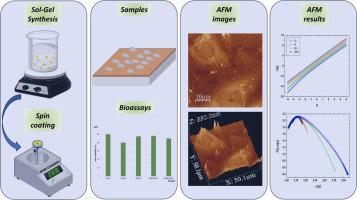Micron ( IF 2.4 ) Pub Date : 2023-10-04 , DOI: 10.1016/j.micron.2023.103548 Ştefan Ţălu 1 , Robert S Matos 2 , Henrique Duarte da Fonseca Filho 3 , Daniela Predoi 4 , Simona Liliana Iconaru 4 , Carmen Steluţa Ciobanu 4 , Liliana Ghegoiu 4

|
In the present study, we report the development and characterization of composite layers (by spin coating) based on magnesium-doped hydroxyapatite in a chitosan matrix, containing human osteosarcoma MG63 cells anchored. Studies regarding the biocompatibility of the composite layers were performed with the aid of a MTT (3–4,5-Dimethylthiazol 2,5-diphenyltetrazolium bromide) assay. The data determined that the composite layers did not inhibit the growth and adhesion of MG63 cells to their surfaces exhibiting good biocompatibility properties. Furthermore, the attachment and development of MG63 cells on the surface of MgHApCh composite layers were investigated using atomic force microscopy (AFM). AFM topographical maps emphasized that the HApCh and 8MgHApCh composite layers surface promoted the attachment and proliferation of MG63 cells on their surface. Meanwhile, in the case of 30MgHApCh layers incubated for 48 h, a slight modification of the morphological features of the MG63 cells. In addition, the effects of the composite layers against Candida albicans ATCC 10231 were also evaluated. The data results from the in vitro antifungal assay depicted that the composite layers successfully inhibited the growth of the fungal cells onto their surface. Morphological and fractal analyses unveil cancer cell surfaces on Mg-containing composite layers with intricate 3D patterns, driven by high-frequency components. Their remarkable complexity and roughness arises from a strong multifractal nature, supporting more effective vertical growth compared to Si and HApCh surfaces. The cell viability reduced of uncoated Si surface is highlighted by its less intense 3D pattern growth. Our results show that the uncoated Si surface promotes lower viability of MG63 cancer cells, with less rough and complex 3D spatial patterns.
中文翻译:

锚定在壳聚糖基质中镁掺杂羟基磷灰石复合层上的癌细胞的形态和分形特征
在本研究中,我们报告了基于壳聚糖基质中的镁掺杂羟基磷灰石的复合层(通过旋涂)的开发和表征,其中包含锚定的人骨肉瘤 MG63 细胞。借助 MTT(3-4,5-二甲基噻唑 2,5-二苯基四唑溴化物)测定法进行了有关复合层生物相容性的研究。数据确定复合层不会抑制 MG63 细胞的生长和粘附到其表面,表现出良好的生物相容性。此外,使用原子力显微镜(AFM)研究了 MG63 细胞在 MgHApCh 复合层表面的附着和发育。AFM 地形图强调 HApCh 和 8MgHApCh 复合层表面促进 MG63 细胞在其表面的附着和增殖。同时,在 30MgHApCh 层孵育 48 小时的情况下,MG63 细胞的形态特征略有改变。此外,还评估了复合层对抗白色念珠菌ATCC 10231的效果。体外抗真菌测定的数据表明,复合层成功抑制了真菌细胞在其表面的生长。形态学和分形分析揭示了含镁复合层上的癌细胞表面,具有复杂的 3D 图案,由高频组件驱动。它们显着的复杂性和粗糙度源于强大的多重分形性质,与 Si 和 HApCh 表面相比,支持更有效的垂直生长。未涂覆的硅表面的细胞活力降低通过其较不强烈的 3D 图案生长而凸显。我们的结果表明,未涂覆的硅表面会降低 MG63 癌细胞的活力,且 3D 空间图案不那么粗糙和复杂。



























 京公网安备 11010802027423号
京公网安备 11010802027423号